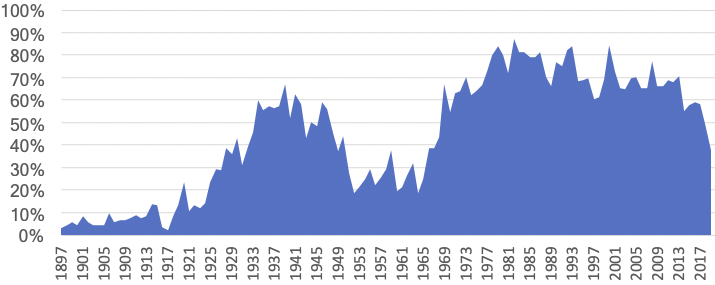Really interesting article on Fox Footy about the game and the current way it is played. We, without a doubt are one of the more exciting teams to watch when we are on, but that style also leads to getting some floggings every now and then.
So how would we like to play? Obviously our style right now is not capable of winning a flag, but are we good enough to try and play a slower and defensive style of game?
Hey, AFL fans — prepare for more ‘slow, boring’ footy. You’ll have to force yourself to like it
AFL
Ben Waterworth
February 24, 2020 8:00am
BEN WATERWORTH@bjwaterworth
Source: FOX SPORTS
We could be seeing slower ball movement and lower scores in 2020. Picture: Michael DodgeSource: Getty Images
Two AFL greats fear the low scoring trend that has recently engulfed the game could worsen in 2020 – and fans might have no choice but to put up with “slow, boring ball movement”.
Despite a raft of rule changes that were initially intended to help boost goalkicking numbers, AFL scoring reached a historic low in 2019, with the average team registering just 80.4 points per match – the lowest since 1967 (78.8).
The AFL said its rule changes, such as six-six-six starting positions and the ability for defenders to take quicker kick-ins, had improved the “appearance” of the game, while it was generally happy with the array of close games.
But dual premiership Kangaroo David King said some teams’ tactics, particularly during the back-end of the season, was dull to watch and often led to lower scoreboard tallies.
“I think the league’s got a real concern with the back-half of last season and seeing teams like Geelong and North Melbourne exiting the backline and slowing the game down. They’re basically taking minutes off the clock, not costing scores on turnover,” King told foxfooty.com.au.
“Scoring’s falling through the floor, so if that’s what we want, then that’s fine. Let’s embrace that it’s going to be around 75 points each. We very rarely get the odd game that’s 120 points to 110 – and that’s because there’s almost a reward for going slow. They don’t fear the boundary line.
“I think the biggest concern is slow, boring ball movement.”
Asked if he enjoyed watching games with team tallies around the 75-point mark, King said: “You have to force yourself to like it. It’s just one of those things where it’s a taste no one wanted to acquire, but you’ve got no other option.”
Dual All-Australian and Saints champion Leigh Montagna said the slower, safer style that has crept into the game often gave younger or less gifted sides a better chance of winning.
“The style of footy that some of the teams are playing now is playing safe with the ball, wide, kick long and be organised behind the ball so you don’t get scored against. That is going to be something that will continue to happen, because it gives the teams that aren’t as talented a chance and it’s going to continue to contribute to low scores,” Montagna told foxfooty.com.au.
The AFL has opted not to introduce any new rules for the 2020 season – a move Montagna liked, as more tweaks won’t necessarily lead to quicker ball movement and bigger scores. But that’s because the modern game is focused on “defending while you’ve got the ball”.
Montagna said it’s incumbent on coaches around the league to play to introduce more aggressive tactics, which will lead to more entertaining games.
“You can make all the rule changes in the world, but unless coaches implement a more attacking game style, you’re never going to see high scoring in the next couple of seasons,” he said.
“Will there be a couple of teams that actually try and break the mould and play aggressive? Or do the coaches not have the nerve to play like a Richmond are doing? Not many other teams are playing that way.
“I’m not sure other new coaches will have the nerve. If you think about it, Rhyce Shaw and the Kangaroos played a safe, build-the-ball-in-the-front-half style – and Carlton did it. Brett Ratten is going to play a kicking, controlling style of game (at St Kilda) … (Justin) Longmuir might let Fremantle play a little bit, just to break the shackles from Ross’ style, but I’m not sure they’re necessarily going to be a high scoring team.”
 )
)